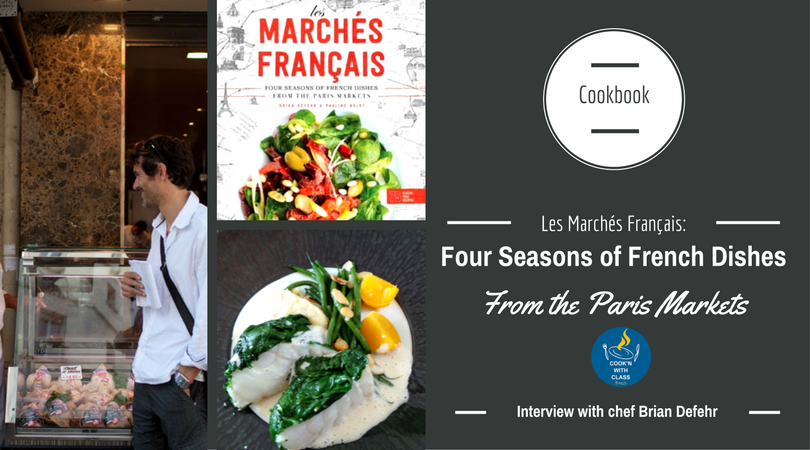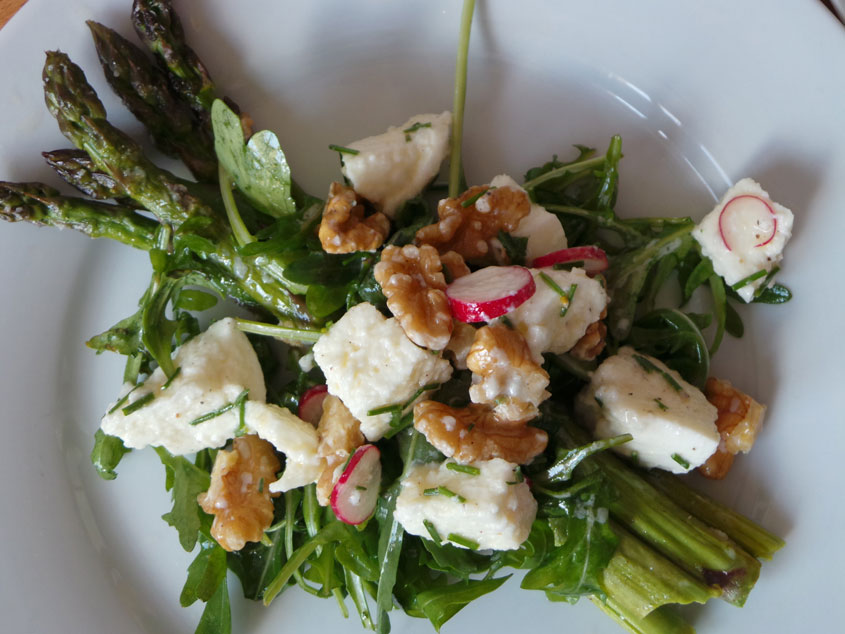
Les Marchés Francais: Four Seasons of French Dishes from the Paris Markets
Some of you have had the pleasure of meeting Chef Brian DeFehr in our French Marketing Classes at Cook’n With Class Paris but did you hear about his recent venture as a French cookbook author?
Brian teams up with his friend, photographer Pauline Boldt to co-author their joint venture – the French Cookbook: Les Marchés Français: Four Seasons of French Dishes from the Paris Markets.
With his first cookbook, Brian takes you along on a journey through French cuisine with what’s fresh and in-season. We asked chef Brian a few questions about the making of. Join him!
Interview with Chef Brian DeFehr, co-Author of French cookbook Les Marchés Français: Four Seasons of French Dishes from the Paris Markets

CWC: Tell us a bit about yourself. Where are you from? How long have you been in Paris and what have you been doing all this time?
BD: I grew up in a small town on the Canadian prairies. The nearest big city was Winnipeg, where I started my university education, and where I started to work in restaurants by chance, just to help pay for my rent and expenses. After finishing university, I realized I loved cooking and decided to pursue a career more professionally, by completing culinary school. Chicago was my choice for that part of the culinary adventure. I eventually moved to Montreal to experience the food scene there, and through friends and contacts I was offered a job as a private chef in Paris in 2001. Working for those fine people led me to a village in the south of France and having my very own restaurant in 2006. In 2009 I started to work in Paris as a freelance chef, starting with a Belgian ambassador, but I’m now working all over Paris and surrounding areas for dinner parties and private lessons. In 2010, I had the chance to be taken on the team at Cook’n With Class, where I’ve been teaching market cooking ever since, on a freelance basis. It’s to a large degree because of my experiences there in putting together spontaneous menus from the local market with my students, that the natural choice for the book subject became ”Les Marchés Parisians.”
CWC: What made you decide to write a French cookbook?
BD: The initial proposition to write a French cookbook came from my co-author and the book’s photographer, Pauline Boldt. She had worked previously with me on various food and cooking projects, and we enjoy challenging each other with new experiences. Pauline runs a design company, 26 Projects, and one day she contacted me with a cookbook design she had put together, and convinced me that it was time to meet the challenge of compiling an inspiring book together.

CWC: What makes this book different from other French cookbooks?
BD: While numerous cookbooks have already drawn their inspiration from French cooking, we believe our book stands out for many reasons:
- The recipes are from a unique voice: a formally trained chef who has worked both in the world of French restaurants (including his own) and currently as a freelance chef who specializes in dinner parties around Paris and private market cooking classes
- We offer a variety of traditional French ideas and more modern and spontaneous creations, with emphasis on using classic and timeless flavor affinities and combinations
- The recipes are rich and satisfying while fitting current ideas for healthy and vegetable-centered eating (they also fit in to the standards for whole foods and gluten-free eating)
- The recipes suit the trend to uncomplicated farm-to-table eating while offering a complex palate and vibrant colors
- While the recipes highlight locally available French products, in many cases suggestions are offered for replacing what may be difficult to find or out-of-season
- Pauline’s photography is fresh and modern with a trained eye in graphic arts, and her reportage style is uncommon for cookbooks
CWC: How long have you been working on the project?
BD: This project had its roots back 3 years ago, when we thought it would be a simple self-published undertaking. But having a major publisher onboard changed everything, creating both a bigger book and a much more involved editing process.

CWC: Did you run into any issues in the realization of the book?
BD: As you can imagine, every book runs into issues, especially the more people that are involved in the project.
Our original concept was something very art driven, both in design and photography, and we had envisioned a series of smaller books of only 20 recipes, but chock-full of gorgeous photography of Paris street and market scenes, raw ingredients in all their natural beauty, and finished shot dishes. But when Running Press, who are now a division of Hachette Books, proposed a contract and took over the publication, one of their preconditions was our agreement of a more standard format of cookbook, with the argument of profitability and a larger market. Along with giving up a certain amount of creative control of the project, other times of tension or setback were sprinkled throughout the project, starting with the publisher informing me that my manuscript was 25,000 words short of the contract stipulation (I thought I was finished!), and ending with numerous episodes of redesigning the front cover only to have one of the 1st designs finally chosen after all. Meanwhile, the launch date had to get pushed from Fall 2016 to Spring 2017 because of the snags over choice of cover.
CWC: What is one thing you are hoping people will take away from this book?
BD: Rather than necessarily laboring over the recipes in an attempt to create the identical dish represented in the photo, with ingredients which might only be available in France in some cases, I would like the book to inspire the reader to make their own variations of the recipes based on what’s seasonally available in their own markets. Only a few people are natural, self-trained cooks, and I would like everyone to enjoy the pleasure of spontaneous cooking based on instinct, where the measuring spoons and scales can be left in storage (that’s much less true for desserts).

CWC: Do you think you would do it again? Write another French cookbook?
BD: The creative process of creating dishes simply based on daily inspiration from trips to the Parisian markets was very rewarding, and although the subsequent steps of recipe codification and editing were more laborsome, I would love to keep writing cookbooks.
Where can we find this delicious joint-venture?
You can pre-order the book on Amazon. The release date is April 18th 2017.
Amazon US
Amazon Canada
Amazon UK
Amazon France
CWC: We’ve included some of Pauline’s photos in this interview. We’d love for you to share with us one of the book’s recipes as a teaser.
For more delicious recipes, you’ll just have to pick up the book.
Medaillons de Lotte en robe d’Epinard
(Monkfish medallions cloaked in Spinach)
Serves
6
Prep Time
20 min
Cooking Time
25 Min
Difficulty
Easy
Season
All Seasons
Ingredients:
2 lbs Monkfish tail, after filleting (save bone for optional sauce)
1 bay leaf
2 sprigs fresh thyme
1/2 C dry white wine
2 T Olive oil
7 oz/200 g fresh, clean spinach leaves, stem removed
Optional fresh herbs such as chive, dill, tarragon or chervil
Procedure:
Preheat the oven to 350ºF/175ºC.
If not already done by the fishmonger, remove central bone from the monkfish, keeping the 2 resulting filets whole. With a boning knife, cautiously remove as much of the grey or pink slimy membrane as possible, to be left with essentially only the pearly white flesh.
For an optional sauce, rinse reserved fish bones, cover with about 1 liter of cold water in a wide pot, and add the bay leaf, thyme, and the wine, bringing to boil. Skim the floating scum and discard, and simmer till fish stock reduces to about 1 C. liquid. Discard the bones, strain, and add 1 C. heavy cream. Simmer and reduce till thick enough to coat back of spoon.
Meanwhile, while the stock is reducing, start the fish. Bring a large pot of water to the boil and wilt the spinach briefly, 15-20 seconds, and pour out through a colander. If you have ice handy, fill a large bowl with ice water and immediately cool down the spinach in the ice water. As soon as the spinach is cool to the touch, empty the bowl in the colander and squeeze out most of the excess water from the spinach. Sprinkle with sea salt to taste, and disperse throughout the spinach with hands and finger tips.
Place the trimmed monkfish fillets in an appropriate-sized baking dish. Press the spinach around all the surface of the monkfish, or at least the exposed 3/4 of it that are not touching the baking dish. Drizzle with olive oil, which will keep the spinach from browning and drying out, and place in 350ºF (175ºC) oven for 20-25 minutes, till white liquid coagulates at bottom of fish and filets are quite firm to the touch in the thickest part, with just a little give. Remove, allow to cool for about 2 minutes and slice into medallions with very sharp knife. Don’t try to slice too thinly, as the fish may just break apart. Add any cooking juices back to pot with sauce, and mix in with 1 Tbs cold butter off heat before serving, adding more salt if desired.
Optionally perk up the recipe by chopping in fresh herbs into the spinach before pressing on the fish for cooking.
I personally served this with a purée of celery root, butter and vanilla bean but you can serve it with any purée of your choice.
Interested in French cooking classes in Paris? Book a class with Cook’n With Class Paris – small group sizes, classes all in English.
